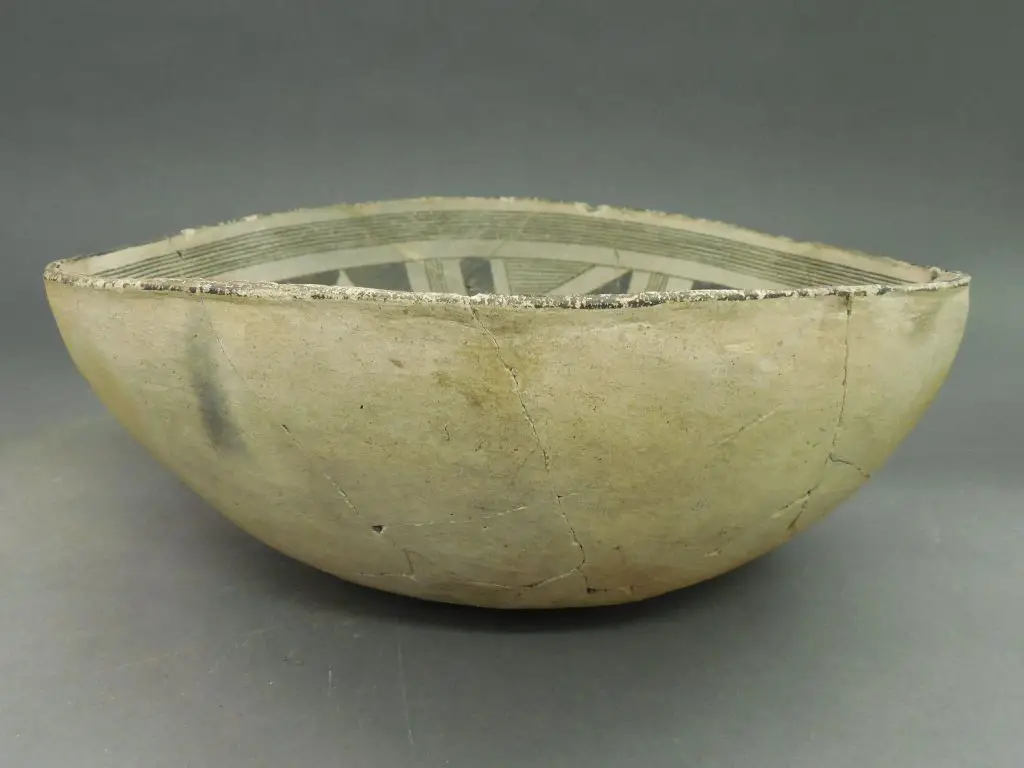Why Is There A Hole In Mimbres Pottery?
Mimbres pottery is the renowned painted pottery made by the Mimbres people who lived in southwestern New Mexico from around 200-1150 CE. The pottery is distinguished by its bold black and white geometric designs and stylized animal figures painted on a white background.
One of the unique features of Mimbres pottery is the hole present in the center of the bowl. This hole was knocked into the bottom of the unfired clay bowl with a stone or wooden dowel tool. The purpose and meaning behind this distinctive hole has been debated by scholars.
In this article, we will explore the history of the Mimbres culture, examine how the pottery was made, discuss theories about the significance of the central hole, and more.
Origins
Mimbres pottery first emerged around 200-500 CE in southwestern New Mexico and southeastern Arizona in the Mimbres River valley, an area near present-day Silver City, New Mexico. The pottery was produced by the Mimbres people, an indigenous culture and maize farmers who lived in pueblos along the Mimbres river. The early pottery was basic brownware pottery often decorated with geometric black-on-white designs.
According to Archaeology Southwest, “We see the roots of Mimbres culture among the first pottery-making populations in the region, beginning around A.D. 200. Archaeologists refer to the period from A.D. 200 to 1000 as the Early Pithouse period because people at that time lived in semisubterranean pithouses.” https://www.archaeologysouthwest.org/free-resources/fact-sheets/who-or-what-is-mimbres/
The early pottery served utilitarian purposes for storing food and water. Over time, the pottery became more elaborate and decorated with painted designs and figures. By 1000 CE, the potters developed a distinctive style featuring black-on-white geometric patterns and imagery of animals, people, and cultural symbols.
Cultural Significance
Mimbres pottery played an integral role in the culture and rituals of the Mimbres people who lived in southwestern New Mexico from around 200-1150 CE. The pottery was used for both ceremonial and decorative purposes. Elaborate symbolic imagery like animals, insects, and geometric shapes adorned the pottery and conveyed significant cultural meaning.
Many of the bowls were found buried in underground chambered rooms along with human remains, indicating they were important ceremonial objects used in burial rituals and the afterlife. The pottery likely represented the cyclical nature of life and death for the Mimbres people. Common imagery like rabbits and butterflies may have symbolized fertility, life, and transformation (Archaeology Southwest, 2020).
In addition to its ceremonial significance, Mimbres pottery was a form of artistic expression. The striking black-on-white painted designs demonstrated great skill and craftsmanship. Decorated bowls displayed in homes celebrated local plants, animals, the changing seasons, and Mimbres cosmology. The pottery reinforced cultural identity and a shared worldview (Hegmon, 2021).
Making the Pottery
Mimbres pottery was made using grey to tan colored clays local to southwest New Mexico that were built up using the coil and scrape pottery making technique. The clay came from the Mimbres River valley and was tempered with crushed pottery sherds or quartz sand to reduce cracking (https://ancientpottery.how/how-to-make-mimbres-pottery/).

The potters created round bowls by rolling out ropes of clay into coils then building the vessel from the bottom up. Each new coil was joined to the previous one using a paddle and anvil technique to bond them together. The surfaces were smoothed both inside and out using polishing stones. The Mimbres people fired their pottery in an open pit using dung as fuel which allowed the vessels to reach a sufficiently high temperature to harden the clay (https://www.archaeology.org/issues/89-1305/features/738-mimbres-bowls-southwest-collapse-reorganization).
The distinctive hole was made prior to firing by cutting out a small circular piece from the soft clay bottom. This hole allowed the Mimbres to hang their completed bowls for display using string or twine when not in use.
Purpose of the Hole
The unique and mysterious hole found in the center of Mimbres pottery bowls has sparked much debate among archaeologists and researchers. The main theories about the hole’s original function center around spiritual and ritualistic purposes.
Many archaeologists believe the hole was related to burial practices and was meant to release the spirit of the deceased. According to the University of Houston Libraries, “The common explanation for the ‘killing’ of the bowl by puncturing or drilling a hole in the bottom was to release the spirit for the journey to the afterworld.” [1] This theory suggests that the hole was seen as a passageway for the soul to leave the physical world.
Similarly, some theories propose that the bowl was placed over the head of the deceased before burial, with the hole allowing their spirit to pass through. As noted by SpookEats, “It is believed that the bowls were placed over the head of the dead at the time of burial, and the hole was the gateway that the soul would pass through on its journey to the afterlife.”[2] Rendering the bowls unusable in the physical world was potentially seen as releasing them for only spiritual use.
While the exact significance is still debated, the hole appears to have held deep spiritual meaning and ritual purpose for the Mimbres people who created these unique bowls.
Archaeological Discoveries
Intact samples of Mimbres pottery with holes have been found at archaeological sites across southwestern New Mexico and southeastern Arizona, primarily in the areas near the Mimbres River. Excavations at the Harris site in the 1920s and 1930s, the Galaz Ruin in the 1930s, and more recent work at the NAN Ranch Ruin have uncovered ceremonial bowls depicting figures and geometric designs with the distinctive hole in the center (On the Trail of the Mimbres).
Archaeologists believe the holes served both functional and ritual purposes. The hole allowed the bowls to be hung for display and may have represented an opening to the spiritual world. Careful study of the undamaged bowls provides insight into the artistry, cultural beliefs, and manufacturing techniques of the Mimbres people. Residue analysis of the bowl interiors reveals they were used to prepare pigments for the painted designs (Mimbres Ware | American Southwest Virtual Museum).
Preservation
There has been significant effort to preserve the remaining Mimbres pottery and artifacts. Many of the original artifacts were looted from gravesites beginning in the late 19th century, damaging the archaeological record and cultural heritage of the Mimbres people. Repatriation efforts have sought to return artifacts to their proper locations and descendants. The Native American Graves Protection and Repatriation Act has aided this process by requiring museums and institutions to return cultural artifacts when requested by tribes. Some repatriation successes have occurred, such as the return of 200 Mimbres bowls by Harvard’s Peabody Museum to Native tribes in 2000 (Source). However, issues remain due to challenges identifying descendants and navigating complex laws. Ongoing preservation efforts by archaeologists and tribal groups continue to protect Mimbres history while respecting descendant communities.
Modern Influences
The intricate designs and symbolism of Mimbres pottery continue to inspire contemporary artists today. Many modern potters are reviving the ancient techniques and iconography of the Mimbres culture in their own work. This has helped spur a renewed interest in Mimbres pottery and a cultural revival among Native American communities.
For example, the Hopi potter Nampeyo reintroduced the traditional Sikyatki pottery styles of her ancestors in the early 1900s, combining it with modern sensibilities. Her revival pottery sparked a widespread renaissance in Hopi-Tewa ceramics that continues to this day (Source). Like Nampeyo’s pottery, much of today’s Native American pottery blends ancient design elements and methods with contemporary artistic expression.
Many Native American artists are also finding inspiration in the symbolic animal imagery of Mimbres bowls. The graphic representations of rabbits, fish, insects, and mythical creatures are being adapted into modern pottery as well as paintings, jewelry, textiles and more. This helps preserve traditional culture while allowing for new innovations and styles.
Overall, the distinctive artistic heritage of Mimbres pottery continues to resonate today thanks to modern revivals and reinterpretations by Indigenous artists. The ancient Mimbres people left a profound legacy that still inspires creativity and cultural pride.
Unanswered Questions
There are still ongoing debates about the exact purpose of the kill holes found in Mimbres pottery. While many archaeologists believe they served a ritualistic or spiritual function, definitively proving this is difficult with the available evidence. Some contend the holes allowed the spirit of the buried person to escape, while others argue they released the pottery vessel’s spiritual power. Further research and analysis of Mimbres artifacts in context could provide more clues about the intent behind adding kill holes.
Areas for additional research include:
- Comparing the locations and sizes of kill holes to determine if any patterns emerge.
- Examining whether certain motifs or vessel shapes correlate with the presence of a kill hole.
- Testing pottery fragments to determine if kill holes were added before or after firing.
- Studying the burial contexts where vessels with kill holes are found.
- Evaluating the symbolism and cosmology of the Mimbres culture for more context.
While the mysterious kill holes will likely never be fully demystified, ongoing interdisciplinary research can continue unraveling their meanings and uses in Mimbres culture.
Conclusion
In summary, Mimbres pottery originated around 200-500 CE in the Mimbres region of southwest New Mexico. The Mimbres people became renowned for their beautiful black-on-white painted pottery featuring intricate geometric patterns and depictions of animals, people, and spiritual imagery. This pottery held deep cultural meaning for the Mimbres, used in rituals, ceremonies, and daily life to reinforce their worldview and spiritual beliefs. The unique feature of a small hole punctured in the bottom of each bowl remains a mystery, with theories ranging from ritual killing to sound resonance.
Archaeological excavations in the early 20th century led to the discovery of many stunningly preserved Mimbres bowls, allowing us to appreciate the artistry and Messages conveyed through these vessels centuries later. Though the Mimbres culture collapsed around 1130 CE for unknown reasons, their pottery endures as a significant art form and window into a vanished society. The mastery of form, design, and symbolism seen in Mimbres pottery provides insight into the cosmology and daily experience of its creators while highlighting the vast cultural achievements of ancient peoples in the American Southwest.



